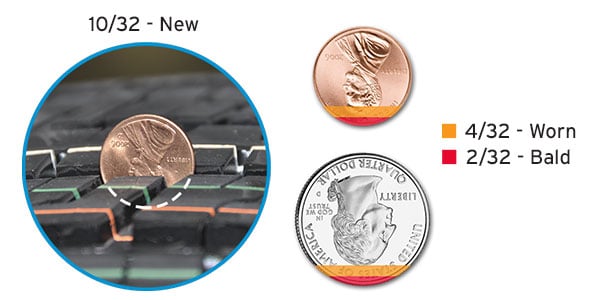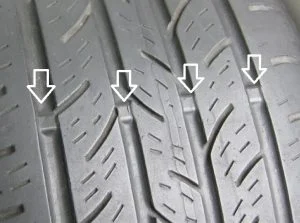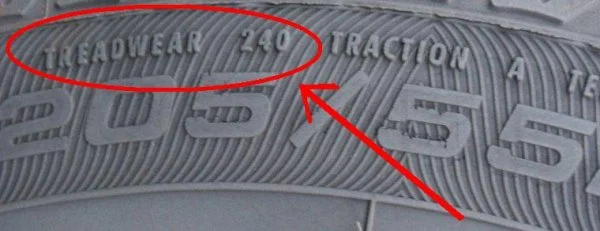Last Updated on 29.07.2024 by hrushetskyy
Used tires tread can be up to 90%, but the average is 6-8/32”. Tires in good condition should have a minimum of 6/32” to be useful, or 4/32” if the tire is 13-14”. The average legal minimum tread depth is 2/32”, but driving becomes unsafe with such a tread. Besides, most dealerships require at least 4/32” tread to trade-in a car without prior a tire change.
Ways to Check Used Tires Tread Depth
- Penny test.
There are two ways of performing the penny test:- Put a penny sideways into a tread groove and look at how much of Lincoln’s head hides in it. If you can see all of it, the tire is worn out with 2/32” tread depth. If a small part of the head is still in the groove, you may have 4/32” tread left.
- Now use a penny with the Lincoln Memorial facing you. If the top of it is covered by the used tire’s tread, you have 6/32” or more.
- Quarter test.
Put a coin between the ribs of the tire and see whether the tread covers a part of Washington’s head. If it does, you have a tread of 4/32” or more.
Image source: tirebuyer.com - Tread depth gauge.
Insert the gauge’s pin into a groove and press it towards the tread. You will get a precise reading of your used tires tread depth in both inches and millimeters.
This gauge is available for about $5 in most auto shops. -

Treadwear indicator bars. Treadwear indicator bars.
Most tires have treadwear bars (usually 6 of them) throughout the grooves indicating the minimum legal depth of 2/32”. There are also tire models that have several grades of bars: at 8/32”, 6/32”, 4/32”, and 2/32”. When a bar becomes visible, the tire is reaching a certain tread depth. - Ruler.
You can also measure the exact amount of tread left with a ruler, just use the 1/16” scale. It is the same as 2/32” and more convenient for this type of measuring.
Checking treadwear is one of the first things to look for when buying second-hand tires.
When using any of these ways, make sure to not only measure tread depth on all tires, but also in different grooves. There may be some uneven treadwear, so one groove can show you enough tread to drive safe, while another one may be worn out.
What Used Tires Tread Depth Mean for You
Different levels of treadwear mean the following things:
- 6/32” and more is sufficient tread.
- 5/32” is still sufficient in most cases, but tires may start to lose traction on wet roads.
- 4-3/32” is the level at which you should think about choosing a new tire/set of tires.
- 2/32” is the average legal minimum for tread depth; at this level your tires are considered bald and unsafe.
It’s also important to remember that used winter tires start to lose traction on icy and snowy surfaces at 6/32”. There may still be some traction till the tire wears to 4/32”, but at that point it’s vital to change tires.
How UTQG Can Help You Estimate Used Tires Tread Life
The United Tire Quality Grading system includes a treadwear index (a 3-digit number), which can tell you how fast your tire will be worn in comparison with the sample tire of the manufacturer.

100 is the standard treadwear of a manufacturer sample tire. A tire with a grade of 80 will wear 20% faster (these are usually using racing tires), whereas a tire with the grade of 200 is expected to last twice as long as the sample tire. Tires with 400-600 grade and higher are considered long-lasting.
If the used tires you are going to buy are of the same brand as your current set, the comparison is possible. It’s obvious that a tire with a 600 grade will last longer than one with a 200 grade. The grade will also be of much help if you also know the treadwear warranty of the particular pre-mounted tire.
NOTE: The UTQG ratings are required for all tires except winter, light-truck, spare, trailer tires, and those with 12” and less in diameter.
How to Prolong Used Tires Tread Life
To make tire tread serve longer, avoid sharp maneuvers and driving on high speeds when your vehicle is loaded. The tire works harder in such cases and more rubber scrubs off and falls on the road.
There are certain driving habits you may want to give up in order to prolong your tires tread life:
- Cornering.
A high-wheel cut, especially performed at high speeds, makes the used tire tread wear faster. Even if you are maneuvering to fit into the parking place, it’s better to be gentle on those turns. - High speeds on elevations.
A single route can include different elevations, but if you handle them at the same highway speed, more tread will wear off. Carrying heavy loads at high speeds when driving on elevations can make the situation even worse. - Hard start and braking.
It’s better to give some time to the wheels and tires to get ready for higher speeds rather than starting sharply. Also, if there is no urgent need, try not to break hard, or the used tires tread life will decrease. - Not avoiding bumps.
Bad roads can not only make your used tire tread wear fast, they can damage them, causing bulges and cracks.
Wise control over your driving style can save twice as much tread as a rough driver.
Why You Shouldn’t Buy Nearly Worn Used Tires
There is a number of dangers resulting from a bald tire:
- Less hydroplaning resistance.
Tires are designed with ribs and grooves to dissipate water on wet surfaces in order to keep traction. The more the used tires tread wears, the shallower its grooves get, and the less the ability to channel water becomes. Thus, the tire loses traction and the possibility of steering loss increases. You may experience this when the tread depth is 5-4/32”. - Snow and ice traction loss.
Most all-season and winter tires are manufactured with smaller grooves or “sipes” to be able to keep a good grip during winter. When used, they expand, creating an environment of lower air pressure within them. Thus, the sipes provide strong traction between the road and the vehicle. They wear out along with the rest of the tread, losing their ability to hold the tire to the pavement in snowy and icy conditions. Sipes can be shallower than the main grooves, so used winter tires tread may lose their performance at mid-wear (5-6/32”). - Excess tire heating.
Tread patterns also act as coolers for the tires, as they heat up due to the friction at higher speeds. Air flows in between the grooves and cools the rubber down constantly. As a tire wears, there is less space for the air, therefore there is less of a cooling effect. Eventually, the tire can heat up beyond its temperature resistance limits and fail. - Air pressure loss.
All tires lose air at some rate, that’s why it’s important to check inflation monthly. However, worn out used tires tread is more likely to be damaged with sharp debris from the road. Such damage can cause excess air loss, under-inflation, and eventually a flat tire. Under-inflation can cause uneven two-shoulder wear and reduce gas mileage. A flat tire ridden in such a condition for some time totals the item.
You can learn more about why it may be risky to buy used tires here.
How to Make a Good Deal When Buying Used Tires
Of course, there are essential advantages of buying used tires. Remember that 5/32” is half tread but not half tread life for a pre-mounted tire. Many sellers claim that, but consider that any tire must be changed at 2/32”. So, if a new one is 10/32”, then half its life is 6/32”. Besides, even though this is the average used tires tread depth, it may be less useful on wet and snowy surfaces.
Nevertheless, if you find a good brick-and-mortar or online tire shop, you will be able to get a good deal and buy Sears tires at a discounted price. There are used tires that have 10/32” tread left and cost 30-50% less than new tires with 11-12/32” tread. Besides, the staff will consult you on the type of tire you need, arrange a delivery, or/and provide additional services.
Share the Knowledge
